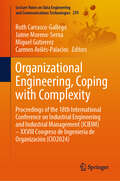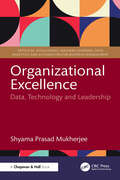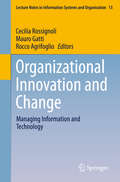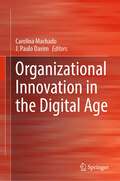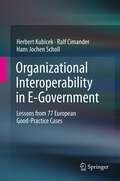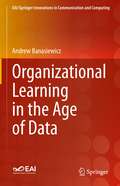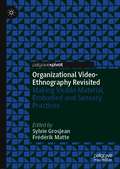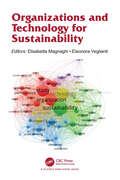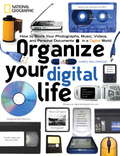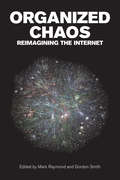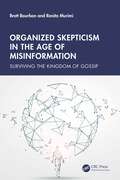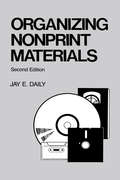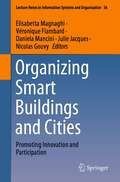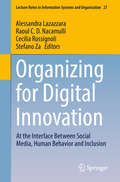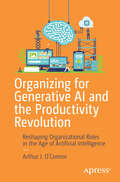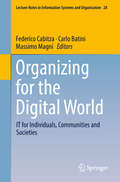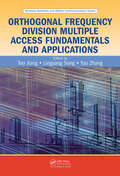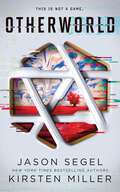- Table View
- List View
Organizational Engineering, Coping with Complexity: Proceedings of the 18th International Conference on Industrial Engineering and Industrial Management (ICIEIM) – XXVIII Congreso de Ingeniería de Organización (CIO2024) (Lecture Notes on Data Engineering and Communications Technologies #239)
by Carmen Avilés-Palacios Miguel Gutierrez Jaime Moreno-Serna Ruth Carrasco-GallegoThis book features a selection of papers presented at the 18th International Conference on Industrial Engineering and Industrial Management (ADINGOR), held on July 4-5, 2024, at Universidad Politécnica de Madrid, Spain. It offers cutting-edge insights into Industrial and Management Engineering, showcasing a broad spectrum of international perspectives. The contributions span diverse topics, including Supply Chain Management, Sustainability, Industry 5.0, Circular Engineering, and the impact of Organizational Engineering on Sustainable Development Goals. The book provides readers with a blend of theoretical advances, innovative methodologies, and practical applications.
Organizational Excellence: Data, Technology and Leadership (Artificial Intelligence, Machine Learning, Data Analytics and Automation for Business Management)
by Shyama Prasad MukherjeeThis book discusses the multifaceted nature of organizational excellence and proceeds to consider the roles played by data, technological advances leading to innovation and value-based leadership in guiding an organization in its journey towards excellence. Moving beyond conventional growth metrics, this book presents excellence as a continuous journey of improvement, integrating data-driven decision-making, digital transformation, and value-based leadership. The book highlights the transformative role of AI and advanced digital technologies in optimizing processes, fostering innovation, and enhancing performance measurement. It also explores Six Sigma, Lean Management, reviews frameworks like Baldridge, EFQM, Excellence Canada, and other quality improvement frameworks, emphasizing the need for continuous process refinement. It is an essential resource for leaders, managers, and professionals in management, strategy, operations, and innovation, as well as scholars in management science and organizational development.This book accomplishes the following: Highlights the role of data analytics and AI in process optimization and innovation; explores the critical factors driving sustained organizational success Introduces scenario planning and robust decision-making to develop strategies Distinguishes excellence from growth and presents it as a continuous improvement journey Considers institutionalized innovation and new product development as essential Covers Six Sigma, Lean Management, and other methodologies, emphasizes governance, ethics, and corporate social responsibility
Organizational Innovation and Change
by Cecilia Rossignoli Rocco Agrifoglio Mauro GattiThis book explores a range of critical issues and emerging topics relevant to the linkages between information technologies and organizational systems. It encourages debate and opens up new avenues of inquiry in the fields of Information Systems, organization and management studies by investigating selected themes of growing research interest from multiple disciplinary perspectives such as organizational innovation and impact, information technology, innovation transfer, and knowledge management. The volume is divided into two sections, each of which focuses on a specific theme: ICT, organizational innovation and change; and ICT and knowledge management. The content of each section is based on a selection of the best papers (original double-blind peer-reviewed contributions) presented at the annual conference of the Italian chapter of the AIS, held in Genoa, Italy in November 2014.
Organizational Innovation in the Digital Age
by J. Paulo Davim Carolina MachadoThis book focuses on how businesses manage organizational innovation processes. It explores the innovative policies and practices that organizations need to develop to allow them to be successful in this digital age. These policies will be based on key resources such as research and development and human resources and need to enable companies to respond to challenges they may face due to the digital economy. It explains how organizational innovation can be used to improve business’s development, performance, conduct and outcomes. Contributing to stimulate the growth and development of each individual in a dynamic, competitive and global economy, the present book can be used by a diverse range of readers, including academics, researchers, managers and engineers interested in matters related with Organizational Innovation in the Digital Age.
Organizational Interoperability in E-Government: Lessons from 77 European Good-Practice Cases
by Herbert Kubicek Hans Jochen Scholl Ralf CimanderIn the e-government research community as well as in many national e-government programs, interoperability is widely seen as a key factor in developing effective and attractive e-services. There is also agreement that interoperability encompasses not only mere technical standards and interfaces, but also includes organizational, legal, and cultural aspects. Several interoperability frameworks have been introduced on national and international levels, and recommendations have been made for the adaptation of enterprise architectures in the public sector. Common to all these approaches is their top-down deductive procedure, which does not connect very well to the real world of e-government projects. In contrast, in this volume, which is based on empirical research, the authors introduce a bottom-up inductive approach to deal with the challenges of interoperability-related governance. Based on so-called "good-practice" cases of interoperability in e-government, they derive concepts and classifications that help to uncover and assess similarities and differences between the cases. As a result, they present an empirically based conceptual framework that details the options for IT governance of interoperability in government. In addition, their findings also make it possible to critically assess and improve other existing frameworks. With this work, which combines different thematic foci as well as a European and a US background the authors situate empirical results in the broader context of theoretical and political reflection. Thus they provide insights into strategic choices for CIOs in e-government at a national or regional level, experiences and lessons learned for managers and developers in e-government projects, and a huge set of empirical data for administrative and political scientists.
Organizational Learning in the Age of Data (EAI/Springer Innovations in Communication and Computing)
by Andrew BanasiewiczThis book discusses the impact of advanced information technologies, such as data processing, machine learning, and artificial intelligence, on organizational decision-making processes and practices. One of the book’s central themes is the interplay between human reasoning and machine logic in the context of organizational functioning, specifically, the fairly common situations in which subjective beliefs are pitted against objective evidence giving rise to conflict rather than enhancing the quality of organizational sensemaking. Aiming to not only raise the awareness of the potential challenges but also to offer solutions, the book delineates and discusses the core impediments to effective human-information technology interactions, and outlines strategies for overcoming those obstacles on the way to enhancing the efficacy of organizational decision-making.
Organizational Video-Ethnography Revisited: Making Visible Material, Embodied and Sensory Practices
by Frédérik Matte Sylvie GrosjeanThis book explores the undeveloped potential of video-ethnography to study the material, embodied and sensory dimensions of workplace practices. With the growing interest in sociomateriality and the development of research on the embodied and sensory dimensions of organizational practices, some methodological challenges of this type of research need to be addressed. The main purpose of this book is to present various forms of video-ethnography that make organizational phenomena visible and help better appreciate the organizing properties of bodies, affects, senses and spaces in workplace practices. To do so, illustrative cases based on video-ethnography was discussed to understand how experiential and unspoken ways of knowing produced through a video-based approach can be made meaningful and relevant to study the material, embodied and sensory dimension of work practices. This book is addressed to researchers and students in social sciences and organizational studies and offers a methodological reflection on how to study the material, embodied, and sensory dimensions of organizational life.
Organizations and Technology for Sustainability
by Elisabetta Magnaghi Eleonora VegliantiThis book presents insights on digital transformation with a multidisciplinary lens. Collecting chapters from several management perspectives, it provides perspectives on the role of various concepts and elements that are needed by our organizations to win in today’s competition. This book is a contribution to the organizational, to the information and communication technology (ICT) as well as to the sustainability discussion. Here, the readers can find heterogenous inputs to better understand the organizational and technological aspects considering a sustainable business approach. This book is for academicians, students and practitioners interested in the interplay among IT-based solutions, organizational entities and sustainability issues.
Organize Your Digital Life
by Aimee BaldridgeNow that digital cameras and music players have become so incredibly widespread, a forest of sound and imagery is blossoming in our homes. We've got digital pictures in the camera, scans on the computer, JPEGS attached to e-mails, and tunes on tiny players. But there's also the old-fashioned stuff: photos in shoeboxes, videos in the attic, documents in desk drawers, songs on tape and vinyl. How do you transform all of these different elements into a convenient archive you can store in your computer, easily reach, and actually enjoy? This book delivers basic step-by-step instruction on streamlining and organizing your "digital life" so you can find what you need instantly and create presentations your friends and family will love. In addition, you'll be amazed at the decrease in household clutter and paper waste. For everyone -from teenagers who thrive on the technical to families with overflowing photo albums and seniors who'd love to collate decades' worth of letters and pictures -this reader-friendly source has all the answers. These easy-to-follow solutions can truly enhance and simplify the hectic, over-saturated lives so many of us find ourselves leading today.
Organized Chaos: Reimagining the Internet
by Gordon Smith Mark RaymondThe Internet is constantly evolving, and has economic, political and social importance as a public good. A coherent strategy for Internet governance is needed to ensure that difficult tradeoffs between competing interests, as well as between distinct public values, are managed in a consistent, transparent and accountable manner that accurately reflects public priorities. In Organized Chaos: Reimagining the Internet, edited by Mark Raymond and Gordon Smith, leading experts address a range of pressing challenges, including cyber security issues and civil society hacktivism by groups such as Anonymous, and consider the international political implications of some of the most likely Internet governance scenarios in the 2015-2020 time frame. Together, the chapters in this volume provide a clear sense of the critical problems facing efforts to update and redefine Internet governance, the appropriate modalities for doing so, and the costs and benefits associated with the most plausible outcomes. This foundation provides the basis for the development of the research-based, high-level strategic vision required to successfully navigate a complex, shifting and uncertain governance environment.
Organized Chaos: Reimagining the Internet
by Mark Raymond and Gordon SmithThe Internet is constantly evolving, and has economic, political and social importance as a public good. A coherent strategy for Internet governance is needed to ensure that difficult tradeoffs between competing interests, as well as between distinct public values, are managed in a consistent, transparent and accountable manner that accurately reflects public priorities. In Organized Chaos: Reimagining the Internet, edited by Mark Raymond and Gordon Smith, leading experts address a range of pressing challenges, including cyber security issues and civil society hacktivism by groups such as Anonymous, and consider the international political implications of some of the most likely Internet governance scenarios in the 2015–2020 time frame. Together, the chapters in this volume provide a clear sense of the critical problems facing efforts to update and redefine Internet governance, the appropriate modalities for doing so, and the costs and benefits associated with the most plausible outcomes. This foundation provides the basis for the development of the research-based, high-level strategic vision required to successfully navigate a complex, shifting and uncertain governance environment.
Organized Skepticism in the Age of Misinformation: Surviving the Kingdom of Gossip
by Brett Bourbon Renita MurimiDrawing from philosophy, information theory, and network science, Organized Skepticism in the Age of Misinformation: Surviving the Kingdom of Gossip offers a novel conceptual framework that views information as a form of gossip.This book challenges the idea that truthfulness is a necessary, or even a relevant condition, of information. Instead, this book develops a conceptual framework in which information is understood as gossip, which fits within a more general account of information and knowledge as constrained but contingent social practices. Using this framework, this book provides a nuanced understanding of the “grammar” of gossip that permeates both online and real‑orld environments and sheds light on the often overused and confused terms of our time: information, misinformation and knowledge.This book offers a fundamental reconfiguration of the evolving virtual interdependence of humans and information technology. It is a key resource for students and scholars in areas relating to social media, information diffusion, human/computer interface, and computational social science.
Organizing Nonprint Materials, Second Edition
by Jay E. DailyThis book surveys the various methods and problems of organizing nonprint materials and describes the use of microcomputers both for storing nonprint items and keeping track of them. It is useful for library school instructors and administrators, media center specialists, information scientists etc.
Organizing Smart Buildings and Cities: Promoting Innovation and Participation (Lecture Notes in Information Systems and Organisation #36)
by Daniela Mancini Elisabetta Magnaghi Véronique Flambard Julie Jacques Nicolas GouvyThe United Nations included sustainable cities and communities in its 2030 SDGs. Cities and, on a smaller scale, neighborhoods, building managers and firms are now adopting technologies and information systems to help achieve the energy, economic, social and environmental transition. This volume gathers contributions on the key organizational success factors for this transition.To do so, it analyzes the role of information systems, use of data, and technological assistance solutions from multiple perspectives. The goal is to develop a framework that can successfully apply information systems to organizational and environmental issues for smart cities and smart buildings. Accordingly, the book addresses living-lab experiment evaluation techniques, and provides critical analyses of the role of the environment, context and users’ behavioral responses. In addition, it discusses key questions on the efficient management of resources, need for appropriate IT solutions, and employing co-creation with users to improve planning and organization.
Organizing for Digital Innovation: At the Interface Between Social Media, Human Behavior and Inclusion (Lecture Notes in Information Systems and Organisation #27)
by Cecilia Rossignoli Stefano Za Alessandra Lazazzara Raoul C.D. NacamulliThis book presents a collection of research papers exploring the human side of digital innovation management, with a specific focus on what people say and share on social media, how they respond to the introduction of specific IT tools, and how digital innovations are impacting sustainability and inclusion. Given the plurality of views that it offers, the book is particularly relevant for digital technology users, companies, scientists and governments. The overall spread of digital and technological advances is enhanced or hampered by people’s skills, behaviors and attitudes. The challenge of balancing the digital dimension with humans situated in specific contexts, relations and networks has sparked a growing interest in how people use and respond to digital innovations. The content of the book is based on a selection of the best papers – original double-blind peer-reviewed contributions – presented at the annual conference of the Italian chapter of the AIS, which was held in Milan, Italy, in October 2017.
Organizing for Generative AI and the Productivity Revolution: Reshaping Organizational Roles in the Age of Artificial Intelligence
by Arthur J. O’ConnorAs leaders plan to make significant investments to harness the power of foundational models such as ChatGPT, they need to understand the changes in organizational behaviors required for the successful implementation of such systems. The size, complexity and nature of this new wave of technologies requires a refresh in roles and responsibilities in conventional IT organizations. This book reveals practical and no-nonsense guidance on how to leverage generative AI to transform your business processes and organizational structures to achieve breakthroughs in efficiency, effectiveness and competitive advantage. Written in a lively, engaging, and often humorous style, this work provides practical insights and timely survival skills for leaders with anonymous but real-world experiences and case studies. If you’re looking to understand how large language foundation models such as ChatGPT are reshaping managerial roles and organizational structures, and how they can leverage this knowledge to survive and thrive in this brave new world then Organizing for Generative AI and the Productivity Revolution is the book for you. What You Will Learn Review the key changes in current state roles and responsibilities that are required to successfully deploy generative AI systems Examine the organizational reporting structures and associated incentives that form a strong generative AI system Understand the financial, regulatory, and operational risks created by organizational behavioral issues that arise when organizations build and deploy large language models Compare the strategic differences in emerging versus traditional organizational behaviors, incentives, roles and responsibilities Who This Book Is For Executives and team leaders at enterprises large and small.
Organizing for the Digital World: It For Individuals, Communities And Societies (Lecture Notes in Information Systems and Organisation #28)
by Massimo Magni Carlo Batini Federico CabitzaThis book argues that “organizing” is a broader term than managing, as it entails understanding how people and machines interact with each other; how resources, data, goods are exchanged in complex and intertwined value chains; and how lines of action and activities can be articulated using flexible protocols and often ad-hoc processes in situated practices of use and production. The book presents a collection of research papers shedding new light on these phenomena and related practices from both academic and professional perspectives. Given the plurality of views that it offers, the book makes a relevant contribution to the understanding and appreciation of the complexity of the digital world at various levels of granularity. It focuses on how individuals, communities and the coopetitive societies of our new, global and hyperconnected world produce value and pursue their objectives and ideals in mutually dependent ways. The content of the book is based on a selection of the best papers - original double-blind peer-reviewed contributions - presented at the annual conference of the Italian chapter of the AIS, which was held in Milan, Italy in October 2017.
Organizing in a Digitized World: Individual, Managerial and Societal Issues (Lecture Notes in Information Systems and Organisation #50)
by Stefano Za Francesco Virili Augusta ConsortiIn a digitized world, organizations and individuals have to deal with several challenges. Both public and private organizations must revise their processes and create new ones to take advantage of new opportunities and respond to emerging threats. At the same time, people need to redesign their personal and professional lives to create situations or conditions conducive to achieving their goals in an ever-expanding digital environment. This book contains a collection of research contributions that address the issues that individuals, organizations, and society face when operating in a digitized world. The plurality of views offered makes this book particularly relevant to academics, businesses, and public sector organizations. It gathers a selection of the best papers (double-blind peer-reviewed) presented at the Annual Conference of the Italian Section of AIS in October 2020 in Pescara, Italy
Original Brand Manufacturing Business Model
by Young Won Park Geon-Cheol Shin Kyung-Soo LeeThis book aims to examine the transition of firms from original equipment manufacturing (OEM) and original design manufacturing (ODM) to original brand manufacturing (OBM), focusing on how businesses can evolve to capture greater value in global markets. It highlights the importance of digital technologies like IoT, big data, and AI in reshaping traditional business models, driving innovation, and enabling firms to move from cost-efficient manufacturing to building consumer-centric brands. The book provides insights into the challenges of this transformation, including structural barriers, market competition, and the need for significant investments in resources, innovation, and leadership. The book is divided into four sections. The first explores the historical evolution of OEM, ODM, and OBM business models and their transformation in the digital era. The second outlines key strategies for transitioning to OBM, covering global positioning, R&D, marketing, production, and supply chain management. It emphasizes the importance of design management, branding, and leveraging partnerships to achieve long-term competitiveness. The third section delves into sustainability and the circular economy, showcasing how OBM firms can integrate eco-friendly practices into their operations to enhance value and address growing consumer demand for sustainability. The final section provides an outlook on the future of OBM, with strategic pathways and policy recommendations to foster OBM business models. A deep case study in the cosmetics industry offers practical examples of successful transitions to OBM, illustrating diverse approaches and best practices. The book also introduces frameworks and tools for firms to assess and enhance their capabilities, providing actionable strategies for business leaders and policymakers. By addressing the complexities of moving up the value chain, this book serves as a roadmap for firms aiming to establish themselves as global leaders in innovation, branding, and sustainability.
Origins of Mind
by Liz SwanThe big question of how and why mindedness evolved necessitates collaborative, multidisciplinary investigation. Biosemiotics provides a new conceptual space that attracts a multitude of thinkers in the biological and cognitive sciences and the humanities who recognize continuity in the biosphere from the simplest to the most complex organisms, and who are united in the project of trying to account for even language and human consciousness in this comprehensive picture of life. The young interdiscipline of biosemiotics has so far by and large focused on codes, signs and sign processes in the microworld--a fact that reflects the field's strong representation in microbiology and embryology. What philosophers of mind and cognitive scientists can contribute to the growing interdiscipline are insights into how the biosemiotic weltanschauung applies to complex organisms like humans where such signs and sign processes constitute human society and culture.
Origins of Terrorism: The Rise of the World’s Most Formidable Terrorist Groups
by Godfrey Garner Maeghin Alarid-HughesOrigins of Terrorism: The Rise of the World’s Most Formidable Terrorist Groups examines the roots of Islamic terrorism, it’s history, and some of the foundational figures in prominent terrorist organizations. Throughout, the book also addresses the use of terrorism, the "hows" and "whys" of terrorists’ goals, and their modus operandi.Historically, insurgency operations have formed the basis of a number of terrorist groups—resistance to western powers, particularly the United States, and what is viewed as their unwanted interference in regional affairs. Sections are devoted to individual terror organizations, including some of the most well-known and resilient global movements—Al Qaeda, ISIS, the Taliban, and Boko Haram, among others. Coverage details where and how they originated, who the principal organizers were, how these individuals worked—or didn’t work—together. In this, the authors look at the circumstances that allowed for these leaders, and their groups’, development and success. In this, the authors expose interesting, little-known stories and facts about the specific upbringing, family life, and personal narrative around these organizations’ founders, as well as ties to other terrorist founders and organizations. For example, the relationship between individuals such as Osama bin Laden and Musab al Zarkawi (aka Ahmad al-Khalayleh)—the founder of ‘Al Qaeda in Iraq’ (AQI), which became ISIS—is examined in detail, providing readers with some of the "stories behind the stories" to understand the prominent figures and underpinnings of major terrorist organizations’ philosophies, formation, and elements that have led to their staying power.Origins of Terrorism will be a valuable resource for security and intelligence professionals, terrorism researchers, and students, providing a unique perspective to understand terrorism and terror movements in considering counterterror efforts.
Orthogonal Frequency Division Multiple Access Fundamentals and Applications
by Lingyang Song Tao Jiang Yan ZhangSupported by the expert-level advice of pioneering researchers, Orthogonal Frequency Division Multiple Access Fundamentals and Applications provides a comprehensive and accessible introduction to the foundations and applications of one of the most promising access technologies for current and future wireless networks. It includes authoritative cove
Orthogonal Image Moments for Human-Centric Visual Pattern Recognition (Cognitive Intelligence and Robotics)
by Dimitrios Hatzinakos S. M. Rahman Tamanna HowladerInstead of focusing on the mathematical properties of moments, this book is a compendium of research that demonstrates the effectiveness of orthogonal moment-based features in face recognition, expression recognition, fingerprint recognition and iris recognition. The usefulness of moments and their invariants in pattern recognition is well known. What is less well known is how orthogonal moments may be applied to specific problems in human-centric visual pattern recognition. Unlike previous books, this work highlights the fundamental issues involved in moment-based pattern recognition, from the selection of discriminative features in a high-dimensional setting, to addressing the question of how to classify a large number of patterns based on small training samples. In addition to offering new concepts that illustrate the use of statistical methods in addressing some of these issues, the book presents recent results and provides guidance on implementing the methods. Accordingly, it will be of interest to researchers and graduate students working in the broad areas of computer vision and visual pattern recognition.
Otherworld: Last Reality Series (Last Reality Ser. #1)
by Kirsten Miller Jason Segel"Full of high stakes, thrillers, and fantastic twists and turns, fans of Ready Player One are sure to love this addictive read." —BUZZFEED Welcome to real life 2.0. Are you ready to play? There are no screens. There are no controls. You don&’t just see and hear it – you taste, smell, and touch it too. In this new reality there are no rules to follow, no laws to break. You can live your best life. It&’s a game so addictive you&’ll never want it to end. Until you realize that you&’re the one being played. Step into Otherworld. Leave your body behind. The frightening future that Jason Segel and Kirsten Miller have imagined is not far away. Otherworld asks the question we'll all soon be asking: if technology can deliver everything we want, how much are we willing to pay?
Ottieni una rendita passiva con Quora e lascia il tuo lavoro: Come ottenere redditi a sette cifre online (Fare soldi online libro 1)
by Marcus PfeifferVorresti fare soldi online? Vorresti guadagnarti da vivere da casa, eppure per qualche ragione hai difficoltà e non guadagni abbastanza? Credimi, alcuni anni fa mi trovavo nella tua stessa situazione. Ho cercato a ogni angolo del world wide web e ho provato a capire come fare soldi sulla rete, ma non ho fatto un centesimo. Peggio: ho sprecato un mare di denaro in corsi, pubblicità, siti web, libri e investimenti sbagliati. Fortunatamente un giorno mi sono imbattuto in un metodo che mi ha aiutato a ottenere una rendita passiva. Però, non mi fraintendere: passiva non significa che non ci sia da lavorare per avere profitti. Significa solo che una volta fatto il lavoro i soldi arriveranno in un flusso continuo, senza una tua partecipazione attiva o particolarmente attiva. Tuttavia finché non hai raggiunto questo livello, in cui i soldi semplicemente arrivano da soli, devi lavorare duramente, e non poco. In questo libro ti mostrerò l’approccio che io ho usato per fare una fortuna. E ti prometto che, se lavorerai duramente come richiesto, arriverai a un reddito a sette cifre in pochissimo tempo.
